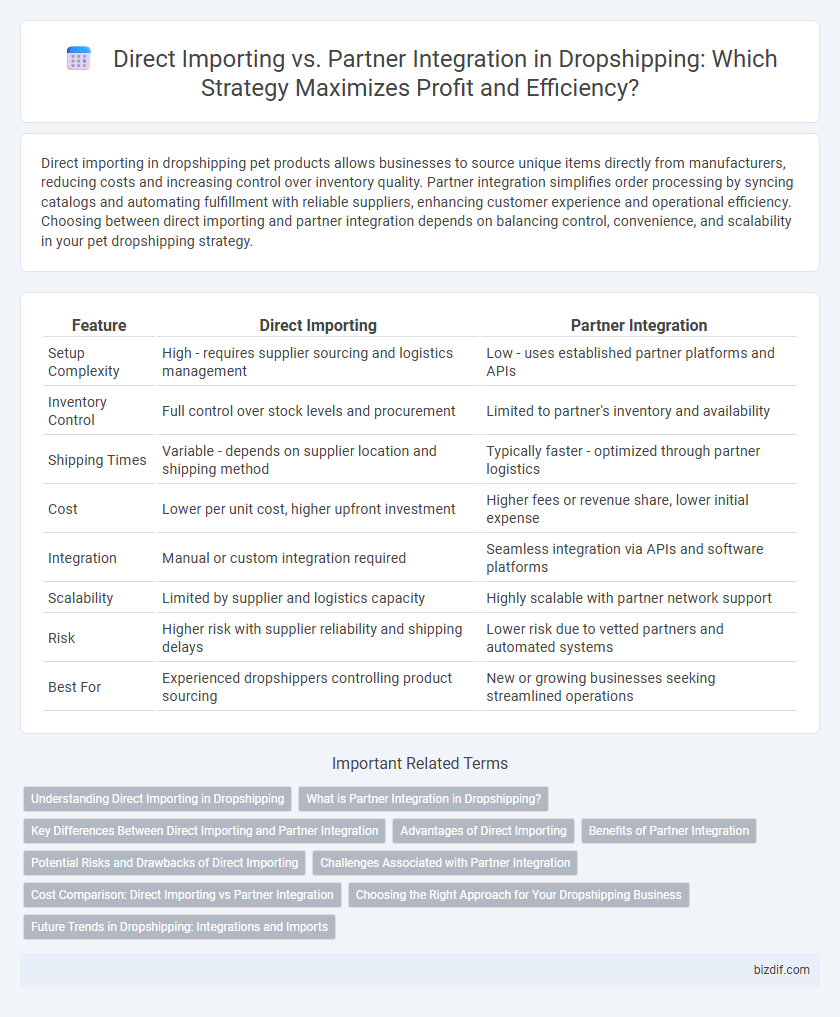Direct importing in dropshipping pet products allows businesses to source unique items directly from manufacturers, reducing costs and increasing control over inventory quality. Partner integration simplifies order processing by syncing catalogs and automating fulfillment with reliable suppliers, enhancing customer experience and operational efficiency. Choosing between direct importing and partner integration depends on balancing control, convenience, and scalability in your pet dropshipping strategy.
Table of Comparison
| Feature | Direct Importing | Partner Integration |
|---|---|---|
| Setup Complexity | High - requires supplier sourcing and logistics management | Low - uses established partner platforms and APIs |
| Inventory Control | Full control over stock levels and procurement | Limited to partner's inventory and availability |
| Shipping Times | Variable - depends on supplier location and shipping method | Typically faster - optimized through partner logistics |
| Cost | Lower per unit cost, higher upfront investment | Higher fees or revenue share, lower initial expense |
| Integration | Manual or custom integration required | Seamless integration via APIs and software platforms |
| Scalability | Limited by supplier and logistics capacity | Highly scalable with partner network support |
| Risk | Higher risk with supplier reliability and shipping delays | Lower risk due to vetted partners and automated systems |
| Best For | Experienced dropshippers controlling product sourcing | New or growing businesses seeking streamlined operations |
Understanding Direct Importing in Dropshipping
Direct importing in dropshipping involves sourcing products directly from manufacturers or suppliers, eliminating intermediaries to reduce costs and improve profit margins. This method requires managing relationships, import regulations, and shipping logistics independently to ensure seamless inventory flow. Understanding direct importing enables dropshippers to maintain better control over product quality, pricing, and delivery times compared to partner integration models.
What is Partner Integration in Dropshipping?
Partner integration in dropshipping involves connecting your e-commerce platform directly with suppliers or third-party logistics providers through APIs or specialized software. This seamless connection automates order processing, inventory updates, and tracking information, reducing manual work and errors. By leveraging partner integration, dropshippers can enhance operational efficiency, improve customer experience, and scale their business more effectively.
Key Differences Between Direct Importing and Partner Integration
Direct importing involves purchasing products directly from manufacturers or suppliers, allowing greater control over inventory and pricing but requiring more logistical management. Partner integration, by contrast, relies on seamless connections with third-party suppliers or platforms, enhancing automation and reducing operational complexity without owning inventory. The key differences lie in control versus convenience, with direct importing demanding hands-on management and partner integration offering streamlined processes through technology.
Advantages of Direct Importing
Direct importing in dropshipping enhances control over product quality and inventory management, reducing reliance on third-party partners and potential delays. It allows for better profit margins by eliminating intermediary fees and enables sellers to customize offerings directly from manufacturers. This method streamlines supply chain logistics, fostering faster shipping times and improved customer satisfaction.
Benefits of Partner Integration
Partner integration streamlines order processing by automating inventory synchronization and real-time tracking, significantly reducing errors and manual workload. It fosters stronger supplier relationships through seamless communication and reliable data exchange, enhancing overall supply chain efficiency. This approach accelerates time-to-market and improves customer satisfaction by ensuring accurate product availability and timely delivery.
Potential Risks and Drawbacks of Direct Importing
Direct importing in dropshipping carries potential risks such as increased shipping times, customs delays, and higher import costs that can reduce profit margins. Quality control challenges arise due to limited oversight, increasing the chances of receiving defective or misrepresented products. Furthermore, lack of reliable communication with foreign suppliers may lead to order fulfillment errors and customer dissatisfaction.
Challenges Associated with Partner Integration
Partner integration in dropshipping often faces challenges such as data synchronization issues, which can lead to inaccurate inventory levels and delayed order processing. Communication gaps between partners may result in inconsistent product information and fulfillment errors, affecting customer satisfaction. Additionally, differing technological platforms and lack of standardized protocols complicate seamless integration and increase operational costs.
Cost Comparison: Direct Importing vs Partner Integration
Direct importing in dropshipping typically involves higher upfront costs, including bulk purchasing, customs duties, and storage fees, whereas partner integration minimizes initial expenses by leveraging suppliers' inventories and handling logistics. Partner integration often reduces operational costs through streamlined order processing and automated syncing, resulting in lower ongoing expenses compared to direct importing. Evaluating cost efficiency requires analyzing shipment volume, handling fees, and scalability between direct import models and integrated partner systems.
Choosing the Right Approach for Your Dropshipping Business
Direct importing offers control over product quality and inventory management, allowing dropshippers to source items directly from manufacturers or suppliers, which can reduce costs and increase profit margins. Partner integration streamlines order processing and fulfillment by connecting your online store with established suppliers' systems, enabling real-time inventory updates and faster shipping times. Selecting the right approach depends on your business scale, resources, and priorities for control versus convenience in your dropshipping operations.
Future Trends in Dropshipping: Integrations and Imports
Future trends in dropshipping highlight increasing reliance on advanced partner integrations that streamline inventory synchronization, order processing, and real-time analytics for improved scalability. Direct importing remains vital for cost reduction and unique product sourcing but faces challenges with longer lead times and customs complexities. Emerging technologies like AI-driven supply chain management and blockchain for transparent tracking are set to enhance the efficiency of both direct importing and partner integration strategies.
Direct Importing vs Partner Integration Infographic

 bizdif.com
bizdif.com